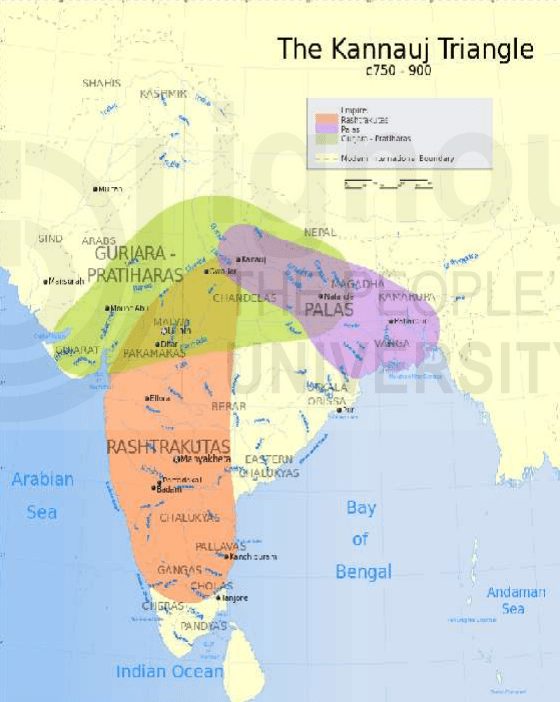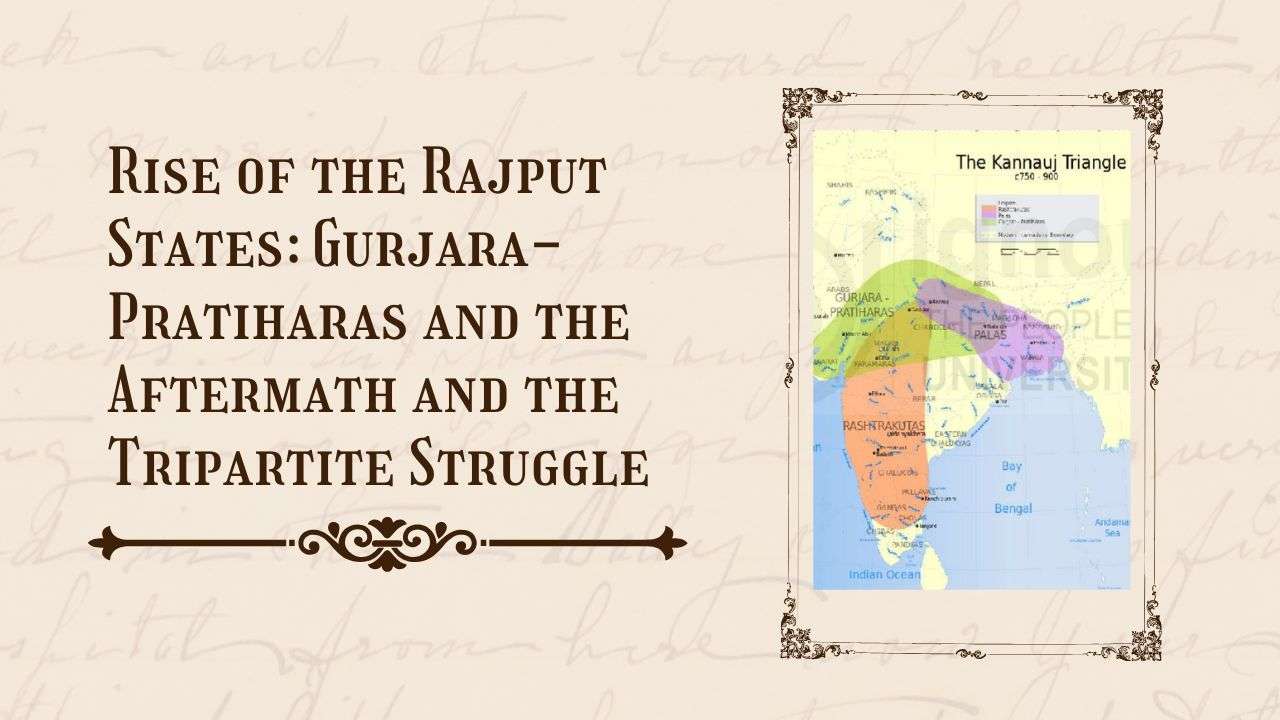Explore the rise of the Rajput states in early medieval India, focusing on the emergence of the Gurjara-Pratiharas and the aftermath of the Tripartite Struggle. Learn how regional powers shaped Indian history during this transformative period.
This content deals with the topic Kanauj after Harsha: Gurjara-Pratihara, Pala and Rashtrakuta dynasty, Tripartite Struggle; other
Political states
The decline of Harsha’s empire in the early 8th century CE ushered in a phase of political fragmentation and regional assertion in north India. This transitional era witnessed the emergence of powerful dynasties, particularly the Rajputs, whose political authority and territorial influence shaped much of early medieval Indian history. A defining feature of this period was the Tripartite Struggle—a prolonged conflict over the control of Kannauj, a strategically significant city that symbolized political dominance in northern India. The struggle primarily involved three imperial powers: the Gurjara-Pratiharas, the Palas, and the Rashtrakutas.
The Tripartite Struggle and the Rise of the Gurjara-Pratiharas
Kannauj, once the seat of Harsha’s empire, became a coveted prize among emerging powers. The contest for its control led to the Tripartite Struggle, with the Gurjara-Pratiharas ultimately gaining an upper hand, although the conflict remained inconclusive for a long time.
The Pratiharas first rose to prominence under Nagabhatta I in the 8th century CE. Amidst internal turmoil in the Rashtrakuta dynasty, Nagabhatta annexed Kannauj, establishing his family’s supremacy in northern India. The struggle did not end with Nagabhatta’s temporary success but was carried forward by his successors.
One of the most prominent rulers of the dynasty was Bhoja I (c. 836–885 CE), the grandson of Nagabhatta. His reign was marked by the consolidation of power and territorial expansion, particularly over Gurjaratrabhumi (modern Jodhpur or Marwar). The early Pratiharas had initially established their base in Ujjaini, a major urban center in western Malwa, before expanding across northern India.
However, the decline of the Pratiharas in the 10th century CE led to a political vacuum, allowing their former feudatories to assert independence. This gave rise to numerous Rajput clans, who established regional dynasties across northern and central India.

Major Rajput States After the Gurjara-Pratiharas
1. The Gahadawalas
The Gahadawalas rose to prominence in the 11th century CE by occupying Kannauj, ruling much of the Gangetic Doab from 1090 to 1193 CE. Their most notable ruler, Jayachandra, is often referred to as the “King of Benares” by Muslim chroniclers, reflecting his association with the religious and cultural center of Banaras (Varanasi). The Gahadawalas were often in conflict with the Chahamanas, signaling intense inter-dynastic rivalries.
2. The Chahamanas (Chauhans)
Originally feudatories of the Pratiharas, the Chahamanas gained independence around 973 CE. The most prominent branch, known as the Chauhans of Sapadalaksha (Jangaladesh), had Ajayameru (modern Ajmer) as their political center. Their rule culminated in the heroic yet tragic reign of Prithviraja III, whose defeat in the Second Battle of Tarain (1192 CE) against Muhammad Ghori marked the end of the dynasty’s dominance. Their major rivals included the Chalukyas and Chandellas.
3. The Chandellas
Another significant Rajput power, the Chandellas, originally served the Pratiharas before asserting independence. They ruled Jejakabhukti (modern Bundelkhand) between the 10th and 13th centuries CE. Their territories included:
- Kalanjar
- Khajuraho
- Mahoba
- Ajayagarh
The Khajuraho temples, built under their patronage, remain a testimony to their cultural sophistication and architectural legacy.
4. The Paramaras
The Paramaras emerged in Malwa, Gujarat, and southern Rajasthan amid the weakening of both the Pratiharas and the Rashtrakutas. Their domain included key towns such as:
- Ujjain
- Dhar
- Bhilsa
- Bhojpur
- Mandu
- Depalpur
Their influence spread widely across central India, and they were central players in the political dynamics of the time.
5. The Chalukyas (Solankis) of Gujarat
Initially serving as Pratihara feudatories, the Chalukyas of Gujarat gained independence by exploiting the decline of the Rashtrakutas. By 950 CE, they had carved out an independent kingdom in the Saraswati Valley with their capital at Anhilawada (modern Patan). They ruled Gujarat and parts of Rajasthan between 940–1244 CE.
6. The Vaghelas
Successors to the Chalukyas in Gujarat, the Vaghelas ruled during the 13th century CE with their capital at Dholka. Two of their ministers, Vastupala and Tejapala, are renowned for building the exquisite Dilwara Temples at Mount Abu.
7. The Kalachuris of Chedi
The Kalachuris, also former Pratihara feudatories, established themselves in Chedi with Tripuri (modern Tewar near Jabalpur) as their capital. Their eastern stronghold was Gorakhpur, and their territories at various times stretched up to Prayagraj and Varanasi. They often clashed with the Paramaras and the Palas.
8. The Guhilas of Mewar
The Guhilas, earlier vassals of the Pratiharas, gained independence in Mewar during the 12th century CE. After the loss of Chittor in 1303 CE, it was Maharana Hammir who recaptured it and laid the foundation of the Sisodia dynasty, reviving the fortunes of the Mewar kingdom. His influence extended as far as Gwalior, Raisen, Chanderi, and Kalpi.
9. The Kachhapagatas
Originally Pratihara feudatories, the Kachhapagatas seized control of Gwalior after defeating the Kannauj ruler. Three branches of this clan ruled the Gwalior residency and eastern Rajasthan during the 10th and 11th centuries CE.
10. The Kachhawahas of Dubkund
These Kachhawahas were subordinate to the Chandellas and did not assume imperial titles. Later, a branch of the Kachhawahas established themselves in Dhundhar, founding Amber and eventually Jaipur.
Later Rajput States in Western and North-Eastern Rajasthan
With the advent of Muslim invasions, several Rajput clans sought refuge in the rugged terrain of Rajasthan, utilizing its geographical advantages to establish new principalities. Key clans that emerged in the western and northeastern parts of Rajasthan include:
- Rathors: Took control of Khed and expanded their territory to include Pali, Barmer, Bhadrajan, Pokharan, Jaitaran, and parts of Bikaner, continuing their rule till 1529 CE.
- Bhattis: Dominated Jaisalmer during the 12th century.
- Deora Chauhans: Ruled the Sirohi region.
- Kachhapagatas (Amber branch): Established Amber (later Jaipur) after expelling the Minas.
Proliferation and “Rajputization”
The early medieval period witnessed the proliferation of Rajput clans, a process whereby sub-clans and minor lineages branched out across different regions. This was often the result of migration, local alliances, or military conquests. Such movement facilitated the absorption of local elements into the Rajput fold—a phenomenon known as “Rajputization.”
This process involved the elevation of warrior groups and local elites into Rajput status through association with already established clans, leading to a complex socio-political network of kinship and power sharing. As these new clans entrenched themselves, they contributed to the consolidation of Rajput polity and cultural identity.
Conclusion
The rise of the Rajput states marked a significant phase in Indian history, characterized by the decline of centralized empires, the emergence of regional powers, and the formation of a new warrior aristocracy. From the Tripartite Struggle over Kannauj to the foundation of resilient principalities in Rajasthan and central India, the Rajputs emerged as the primary political and military force in much of northern and western India until the advent of the Delhi Sultanate. Their legacy is enshrined not only in political history but also in the architectural, cultural, and martial traditions of India.
References and Further Reading
- R.S. Sharma, Early Medieval Indian Society: A Study in Feudalisation, Orient Longman, 2001.
- Romila Thapar, Early India: From the Origins to AD 1300, Penguin, 2002.
- Satish Chandra, Medieval India: From Sultanat to the Mughals, Vol. I, Har-Anand Publications, 2004.
- A.L. Basham, The Wonder That Was India, Rupa Publications, 2004.
- B.N.S. Yadava, Society and Culture in Northern India in the Twelfth Century, Motilal Banarsidass, 1973.
- D.C. Ganguly (ed.), The Age of Imperial Kanauj, The History and Culture of the Indian People, Vol. IV, Bharatiya Vidya Bhavan.
- H.C. Raychaudhuri, Political History of Ancient India, Oxford University Press.
- K.A. Nilakanta Sastri, A History of South India, Oxford University Press (for Rashtrakuta side of the Tripartite struggle).
- J.L. Mehta, Advanced Study in the History of Medieval India, Vol. I, Sterling Publishers.
- Peter Hardy, Historians of Medieval India, Luzac & Co., 1960 (for historiographical analysis).
- Notes Of https://egyankosh.ac.in/bitstream/123456789/61919/1/Unit-9.pdf
Relevant Post
